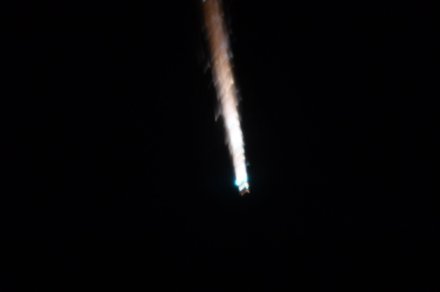ISS astronauts witness fiery end of Russian cargo ship
![]()
By
Trevor Mogg
Astronauts on the International Space Station (ISS) witnessed the fiery demise of a Russian spacecraft on Wednesday as it burned up in Earth’s atmosphere at high speed.
Just hours earlier, the Progress MS-23 spacecraft, identified by NASA as Progress 84, had been docked at the orbital outpost.
Thankfully, the spectacular event was entirely planned and part of a routine procedure for Russian cargo ships departing the ISS.
But unusually, the burn-up was witnessed by the crew aboard the space station, with NASA astronaut Jasmin Moghbeli able to get some photos of the spaceship’s final moments.
“Earlier today, Roscosmos cargo vehicle Progress undocked and departed from space station,” Moghbeli, who arrived at the ISS for the first time in August, wrote in a social media post (below) that included the dramatic images.
Earlier today, @roscosmos cargo vehicle Progress undocked and departed from @Space_Station. Nearly four hours after undocking, I was able to spot it burning up in the atmosphere and even capture a few photos of it. It happened faster than I thought and was only visible for about… pic.twitter.com/P1aFj2HvEo
— Jasmin Moghbeli (@AstroJaws) November 29, 2023
The American astronaut said that she was able to spot the spacecraft burning up about four hours after it undocked from the space station following a six-month stay in orbit.
“It happened faster than I thought and was only visible for about 2-3 minutes,” Moghbeli said. “It reminded me a bit of fireworks, especially when it broke apart.”
She also thanked ground staff who told where to look so that she would have the best chance of witnessing the space-based fireworks show.
The Progress MS-23 cargo ship docked with the ISS in May, bringing with it supplies such as food and equipment.
Unlike SpaceX’s Dragon spacecraft, the Progress vehicle is not reusable, so disposing of it by burning it up in Earth’s atmosphere is the most efficient way of getting rid of it. The Progress spacecraft also acts as a giant trash can, and so will have been full of garbage from the station when it met its fiery end on Wednesday.
Editors’ Recommendations
-
10 space station questions answered on its 25th anniversary -
How to watch SpaceX deliver cargo and experiments to the ISS this week -
Space station leak prompts NASA to rework spacewalk schedule -
Thursday’s spacewalk at the ISS has just been postponed -
Space station crew investigating yet another coolant leak
Not so many moons ago, Trevor moved from one tea-loving island nation that drives on the left (Britain) to another (Japan)…
How to watch two astronauts spacewalk to check the ISS for microbes

[UPDATE: NASA has called off the spacewalk while it waits for the completion of an investigation into a leak that affected the Nauka module earlier this week. We will update this page with the new schedule once it becomes available.]
This week will see two astronauts perform a spacewalk from the International Space Station (ISS) as they collect samples from the station’s exterior to use in scientific research. The two astronauts will be NASA’s Loral O’Hara and European Space Agency (ESA)’s Andreas Mogensen, and the spacewalk will take place on Thursday, October 12.
NASA’s record-breaking astronaut arrives home safely

NASA astronaut Frank Rubio shortly after returning to Earth after becoming the first American astronaut to spend a full year in orbit. NASA
Frank Rubio has arrived home safely after spending 371 days in space — a record for a NASA astronaut.
NASA is seeking help to crash the space station at the end of its life

The International Space Station (ISS) is set to be decommissioned in 2031, at which point it will have spent three decades orbiting Earth.
But NASA doesn’t want to leave the 356-foot-long (109-meter) facility drifting in orbit as it would add to the growing amount of hazardous space junk already in low-Earth orbit and would risk creating even more if it collided with another object.
